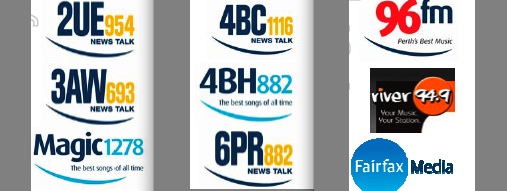Fairfax Media never really achieved the benefits of fully integrating its Radio Division into the rest of the predominantly print company in at least two key areas, news and sales. Fairfax now plans to sell its radio stations and, based on recent media sales, this would value the Radio Division at around $250 million.
Potential buyers will of course include John Singleton’s Macquarie Radio Network, which has been talking up the asset sale for some time. The Financial Review’s Neil Shoebridge speculates that Singleton will team up with private equity firm Archer Capital to stump up an acceptable offer for the network. But Singleton will not be the only buyer. Now that he has set the hares running through his public speculation, Singleton will face competition from other private equity buyers, other media institutions and sundry wealthy investors. Speculation for buyers includes Kerry Stokes, Lachlan Murdoch, Gina Reinheart and many others. A report in The Daily Telegraph also lists Harold Mitchell as a possible buyer, but it is all speculation until Fairfax has firm offers on the table. Some Fairfax insiders are speculating that a deal has already been done and the market may see a fast completion before the end of the financial year, while others say Singleton began the process and now Fairfax is willing to wait and see who else comes out of the woodwork.
Fairfax Media bought most of its stations from Southern Cross in 2007 for $520 million, and also inherited a small number of Rural Press stations in South Australia when Fairfax merged with Rural Press. It has since also acquired digital radio channels as an automatic knock-on from owning existing licenced radio stations. Fairfax Radio station assets include:
– Talk stations 4BC, 2UE, 3AW and 6PR
– Music stations Magic Melbourne, 4BH Brisbane and 96fm Perth
– Regional stations 4BU, Hits Bundaberg, 5RM, 5AU, 5CS and Magic stations in South Australia
– A regional narrowcast network branded Kix
– A digital radio country music channel in Melbourne and other currently unused digital spectrum in the capital cities
Drawing on figures from last year’s annual report of $22 million earning (EBIT), and based on the current multiple for radio sales of ten time earnings, achieved by the sales of Austereo and Murdoch’s half share in DMG, the network would be worth about $220 million. But recent part year indications are that Fairfax Radio will achieve higher earnings this financial year, closer to $30 million. Based on those figures Fairfax Radio could fetch anywhere between $220-300 million.
Revenue reported last year for the radio network was $106 million. 3AW is the network’s most profitable station and 2UE is its least profitable. Until this year 2UE had very high overheads, although the recent changes to its lineup have reduced costs and have the station set to at least break even within the next 12 months. 4BC is a nice quiet little earner for the company, while 6PR has suffered ratings declines recently, which has taken the shine off its profit in the past 12 months.
Fairfax Radio is headed by Graham Mott, a seasoned radio manager, who has guided the network to improved ratings and tighter cost controls since it came under the Fairfax umbrella four years ago. It is not known whether Mott would stay on after any sale. Radio staff have been instructed that all comment on the sale must come from Fairfax Media CEO Greg Heywood, so no one in Fairfax Radio has been available to radioinfo for comment. We reported the only available public comments from Heywood yesterday.
When Fairfax Media bought the radio stations from Southern Cross in 2007, it was reported that the merger would create “synergies” to improve profit. In Melbourne those synergies came from the co-location of 3AW and Magic inside the new Fairfax building, and there were synergies in payroll and human resources areas, but crucial content and sales integration did not happen.
The radio industry has for some time been watching and wondering when structural changes would occur in news and sales. It would have been obvious for the company to link its radio and print newsroom systems together for instance. This never happened. Rivals also expected the company to integrate selling across both platforms, but this also never happened, except for one loosely linked summer special campaign which offered radio buyers discounted ads in Fairfax newspapers if they bought radio, and vice versa.
The fact that such integration was not achieved actually now makes it easier for the company to unravel its radio assets from the rest of the company.
Depending on who is interested in the companies, ACMA and the ACCC are likely to take a close interest in the sale if the new owner is likely to exceed ACMA ‘control’ limits or the new buyer could decrease media market competition.
In marketing terms, 2UE and 3AW are closer in editorial style to rival newspapers Herald Sun and Daily Telegraph than the Fairfax owned publications The Age and Sydney Morning Herald, so this may also have been a strategic factor in Fairfax’ decision to put the radio assets on the market, although in practical terms there did not seem to be any significant factors one way or another in radio/print cross promotions.
As Fairfax battles print unions in its efforts to modernize its newspaper division, the radio division stands in stark contrast, with a far more efficient content creation workforce turning out countless hours of content for far less than the company’s newspapers cost to produce. It will be a good acquisition for the right company.
Perhaps the final word, from a radio point of view, should go to Fairfax Radio 3AW’s Neil Mitchell, who tweeted when the news was announced: “We’ve had plenty of owners and it won’t make much difference.”

